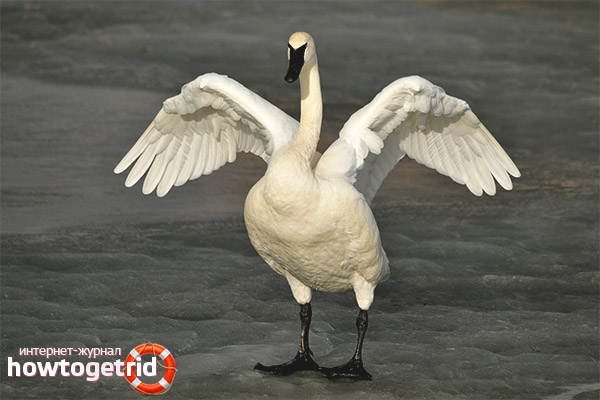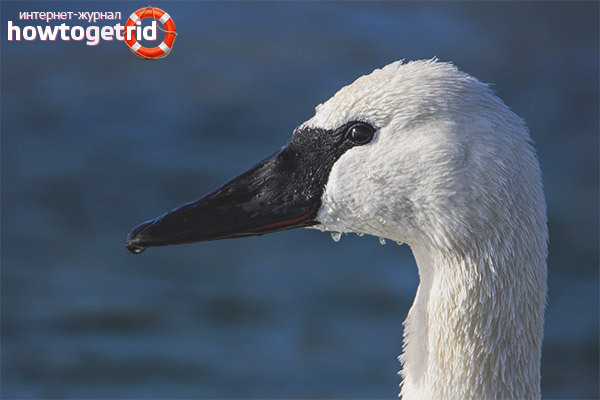The content of the article
Today, the swans for us are a kind of symbol that personifies the purity of the soul, loyalty and love. Their appearance they cause admiration in people. Feature of the form is a special majestic beauty. Long life and monogamy. Consider one of the subspecies of these beautiful birds - the trumpeter swan.
The trumpeter swan lives in North America. This subspecies of swans is distinguished by its secrecy. Individuals settle in areas of tundra and forest-tundra, which are least accessible to humans. This species is endangered, therefore it is in the Red Book. This is due to the fact that they were hunted a lot to get valuable meat, as well as fluff. In addition, due to the construction and expansion of industry suitable living conditions is becoming less.
Description
Representatives of this subspecies are among the largest of all waterfowl. A male who has reached maturity may have a weight of about 12 kg.Females grow up to 9 kg. The body length is about 140-170 cm. But there are individuals whose length is more than 10 cm. The wingspan of these large birds is 200-230 cm.
The female trumpet swan differs from the male only in size. They have very beautiful white plumage. Outside the feather is dense, under it there is a thick cushioning. Thanks to him, the bird can withstand even severe cold. Individuals up to the age of three have a different color of feathering. They are darker, for example, gray-brown or dark gray. This swan has a black beak. The chest is very expressive.
The bird received the name for being able to make sounds that resemble the sound of a trumpet. This sound is obtained due to the fact that the larynx and trachea has a special structure.
The sounds that this bird makes can be heard at a very long distance, up to several kilometers.
Habitat
- swamps and lakes;
- estuaries and bays;
- slow flowing rivers.
Only those individuals that live in Alaska are migratory. They fly to the south of the peninsula and to the northern part of the United States. Those swans who live in the north and west of Canada do not fly away for the winter.
Breeding
A trumpeter swan builds a nest right near the water. They can be seen in the thickets. Every year the bird updates the nest and puts it in order. As a result, the nest can reach more than 3 meters. A pair of swans builds it from their fluff, as well as grass, moss and twigs.
The breeding season in different populations begins at different times. Migratory trumpeters return to their nests around mid-March. Birds that remain to winter in place may start repairing their nest in February. Eggs appear in April-May. She clutch can have a different number of eggs. They can be from 3 to 30 pieces. It depends on how well the swans eat, as well as on their age. Eggs swans incubate for about 35 days. When the female incubates them, the male performs the function of protection.
When the chicks hatch, they remain in the nest for the first two days. On the second day, parents take them with them to find food.Nestlings feed on worms, larvae and some algae.
When chicks first enter the water, parents may no longer visit their nest. The chicks are resting on their backs, basking in the sun. The first molt of a young swan occurs at about 80 to 120 days old. After that, they begin to learn to fly.
Nutrition
Basically, these swans feed on coastal plants and algae. Adult trumpeters do not fully dive into the water to get food for themselves. They submerge only the head and long neck in water. This neck allows the bird to get food, which is even at a depth of 1 meter. In addition to plant foods, their diet also includes worms, insects, mollusks. On land, they can eat leaves and grass.
If there are fields sown with corn or millet not far from the habitat of the trumpet swans, the birds can eat the crops. But, basically, this happens only in the period of migration or when there is a lack of food in their natural environment.
Security

Several centuries ago, these birds lived throughout the territory of modern Canada and the United States. But as a result of active hunting for them, the number of individuals has sharply decreased.They were hunted to get tasty meat, as well as valuable feathers and feathers, which were used for various purposes. They were made from pillows, jewelry, used for writing. Too intense hunting, as well as a decrease in the territories where these birds lived, led to dire consequences. Scientists at the beginning of the twentieth century were able to count only about 70 individuals.
Hunting these birds is prohibited. In addition, several reserves have been created. The work of preserving the subspecies was not in vain. To date, these swans have about 30 thousand. But, despite the fact that their number is growing, the ban on their destruction remains in force. The reserves not only protect the birds, but also help them to raise chicks. In addition, the increase in the number of engaged farms and nurseries.
Interesting Facts
- Scientists have determined that the color of the plumage of these birds depends on where they live. In warmer areas they are darker. Absolutely snow-white trumpeters live in the most northern latitudes.
- They nest in places difficult to reach for humans. But, if they are not disturbed, they can live not too far from a person.
- Some individuals come to Russia in the winter.More than three hundred birds arrive at the Altai Lake.
- These birds take care of their relatives. If one swan is sick, they may even postpone the flight.
- In captivity, representatives of the subspecies can live for about 30 years.












To send